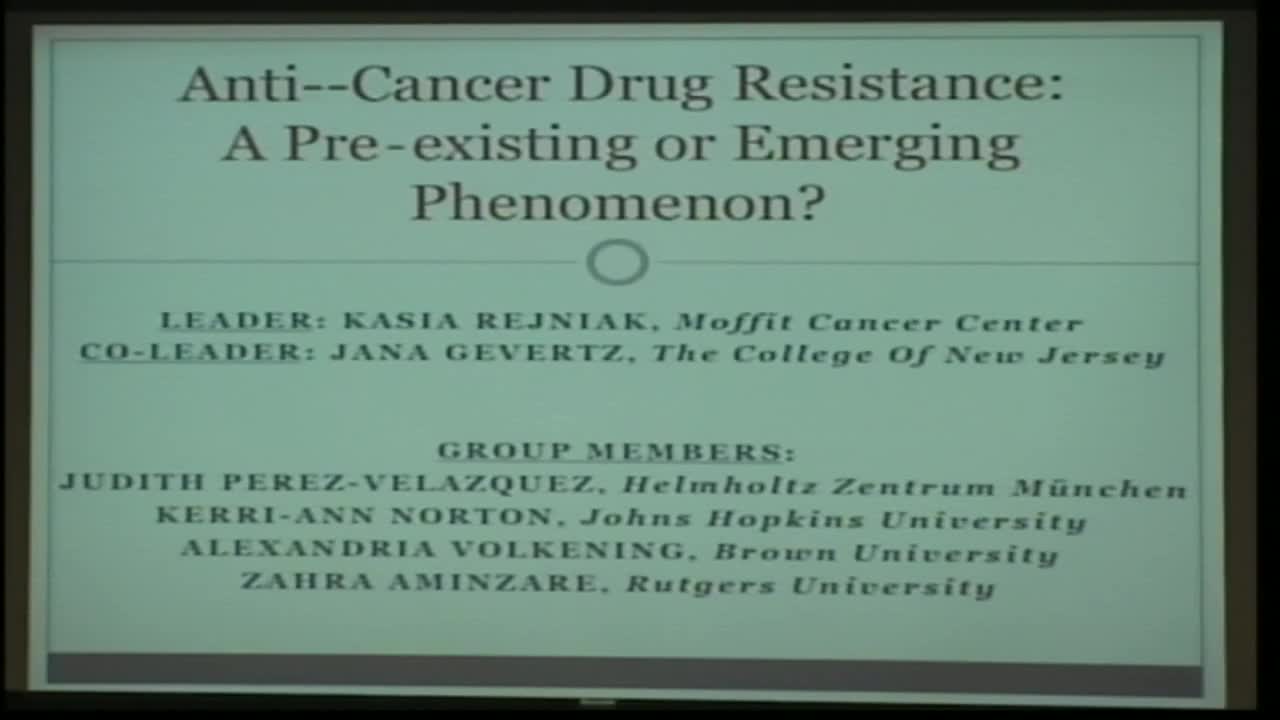Anti-Cancer Drug Resistance: A Pre‐existing or Emerging Phenomenon?
Presenters
September 9, 2013
Abstract
1. Motivation
Practically all chemotherapeutic agents and potentially many targeted therapies that are used in the clinical treatment of cancer lead to drug resistance. There is, however, no consensus on whether drug resistance is pre-existing or acquired. Pre-existing drug resistance means the cancer contains a subpopulation of drug resistant cells at the initiation of treatment, and that these cells become activated or selected for during the course of therapy. On the other hand, acquired resistance involves the tumor gradually developing drug resistance due to drug action and other factors, such as microenvironmental or metabolic conditions.
Mechanisms of drug resistance are currently being studied in cell culture. Biologists produce drug-resistant cell lines by exposing the cells to the drug, collecting the surviving cell subpopulation, and repeating this process through several passages until the remaining subpopulation of cells no longer responds to the treatment. While this is an effective way to generate a resistant cell population, this in vitro process does not reveal whether the surviving cells become more resistant to the chemotherapeutic treatment with each cell passage, or if a small population of susceptible cells was present from the beginning and
simply has overgrown the other cells during the course of the experiment.
This poses several questions. If the hypothesis of a pre-existing population of resistant cells is true, what mechanisms enable those cells to resist the drug action of the often multiple chemotherapeutic treatments that may be given to a patient sequentially or in parallel? If the hypothesis of gradual emergence of drug resistance is true, what factors contribute to the development of acquired drug resistance?
2. Objectives
(a) Develop a hybrid discrete-continuous model of cancer response to a single drug or drug combinations based on tumor histology and immunohistology.
(b) Simulate and compare outcomes of possible resistance mechanisms, such as pre-existing populations of resistant cells; role of cancer stem cells; drug penetration of tumor tissue architecture; dynamics of drug absorption and efflux; role of irregular metabolite gradients.
(c) Determine a hierarchy of factors that contribute to tumor resistance to anti-cancer drugs.
We will use the agent-based techniques (such as cellular automata or particle-spring models) and partial differential equations to develop a hybrid model of tumor response to chemotherapy. We will employ image analysis and classification methods to analyze histology images and define model initial conditions. Computational simulations will be conducted to investigate model outcomes under various drug resistance mechanisms.
3. Reviews
Tredan O, Galmarini CM, Patel K, Tannpck IF, Drug resistance and the solid tumor
microenvironment, J. Natl Cancer Inst, 2007, 99:1441-1454
Dean M, Fojo T, Bates S, Tumor stem cells and drug resistance, Nature Reviews Cancer, 2005, 5:275-284
Lambert G, Estevez-Salmeron L, Oh S, Liao D, Emerson BM, Tlsty TD, Austin RH, An
analogy between the evolution of drug resistance in bacterial communities and malignant tissues, Nature Reviews Cancer, 2011, 11:375-382
